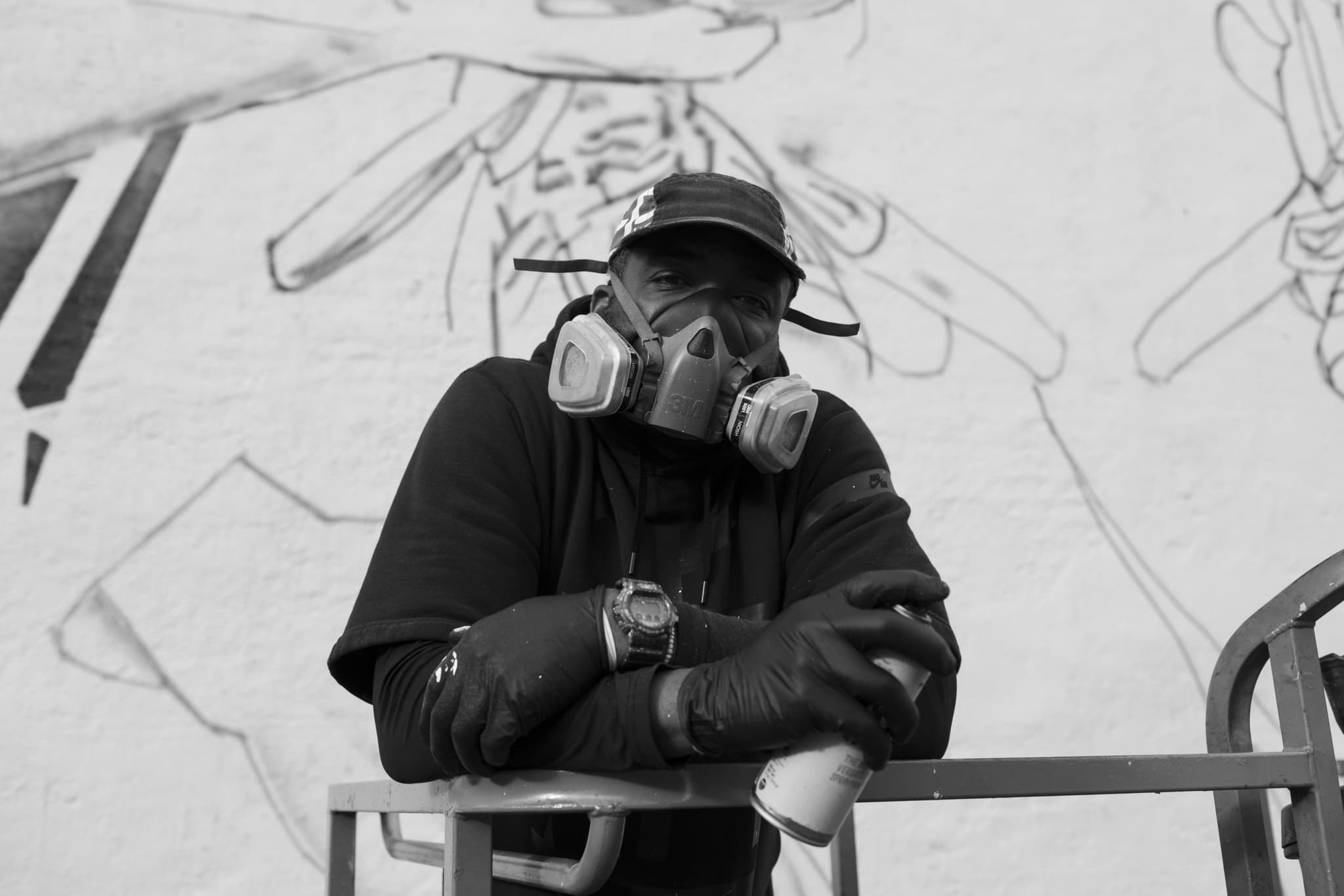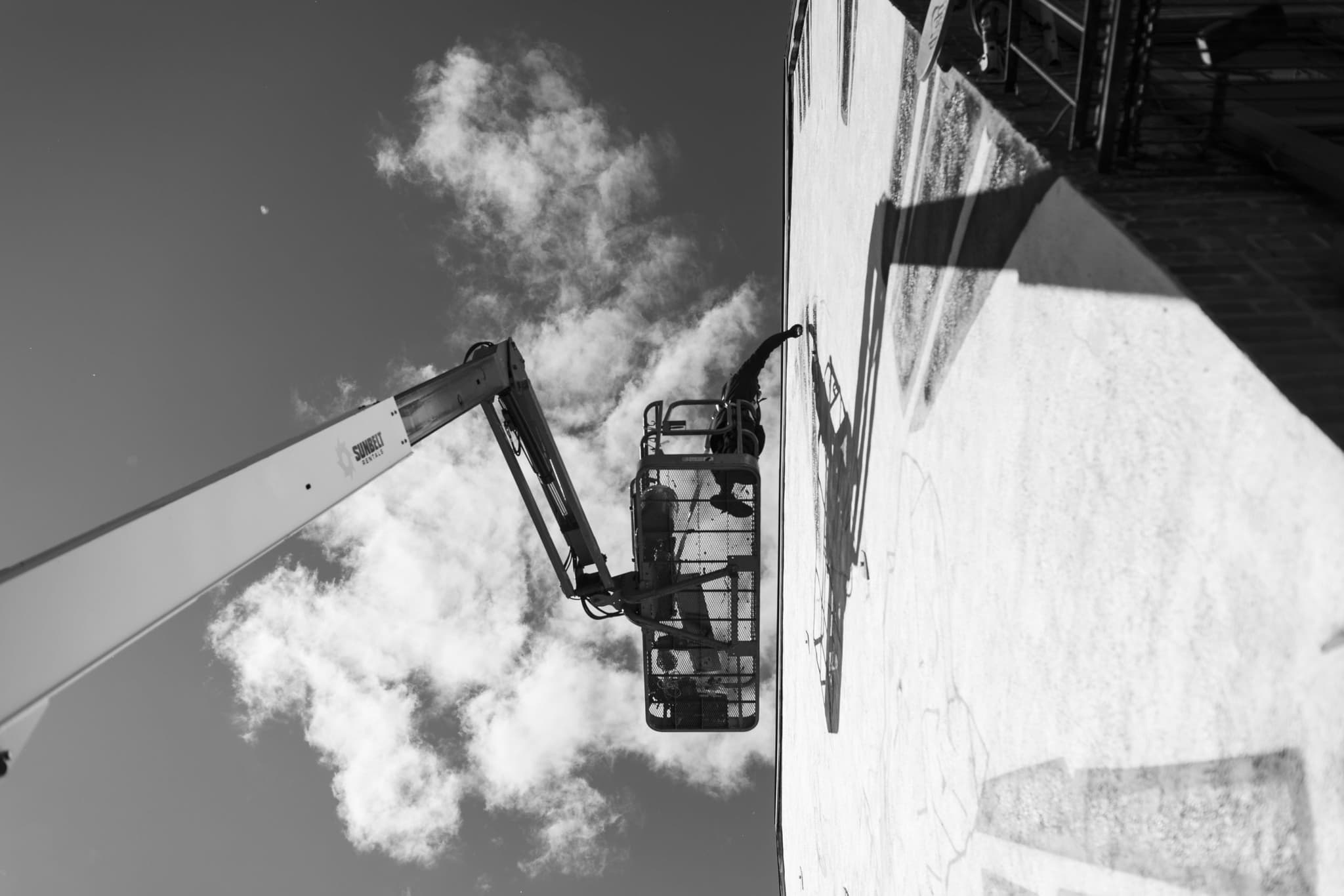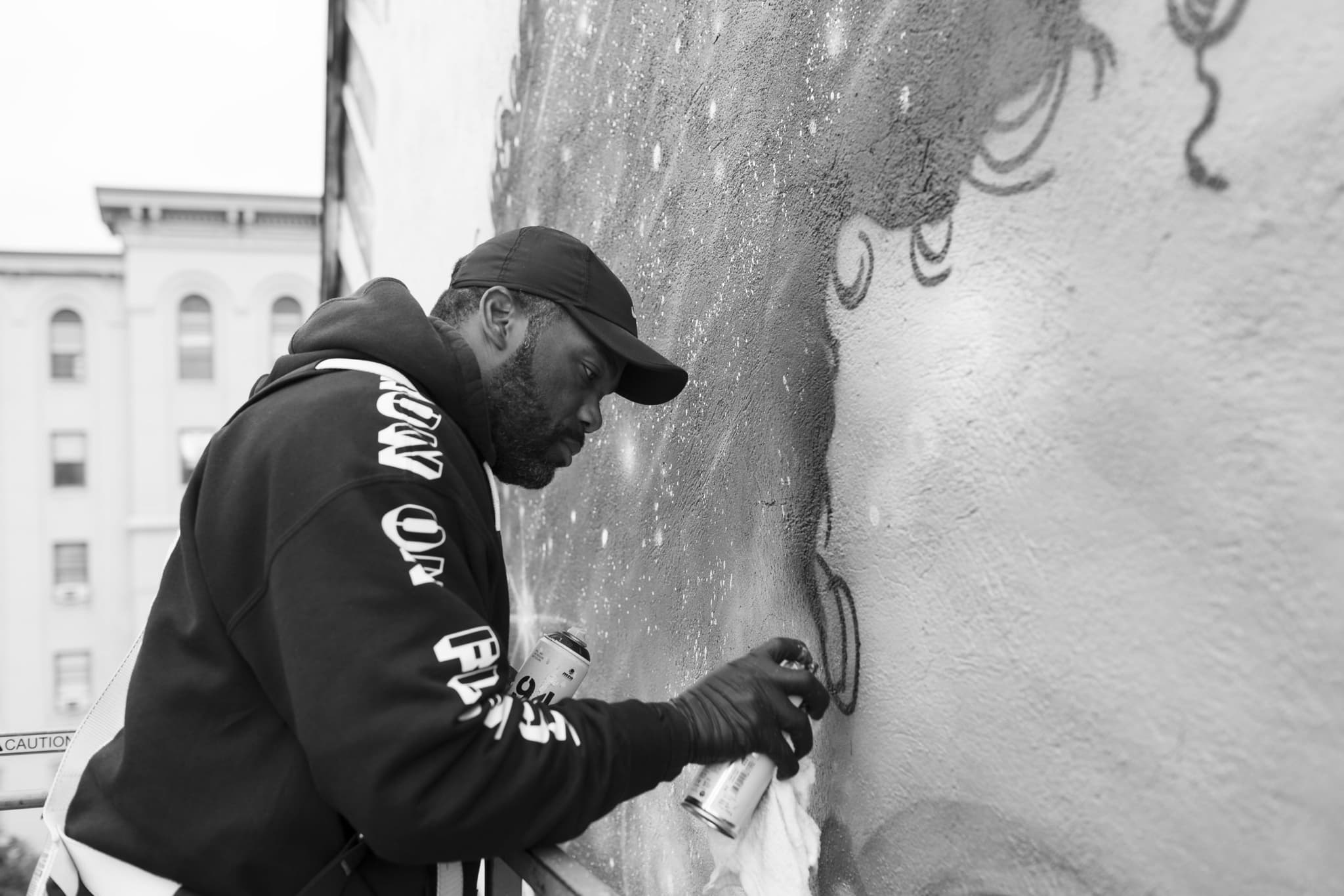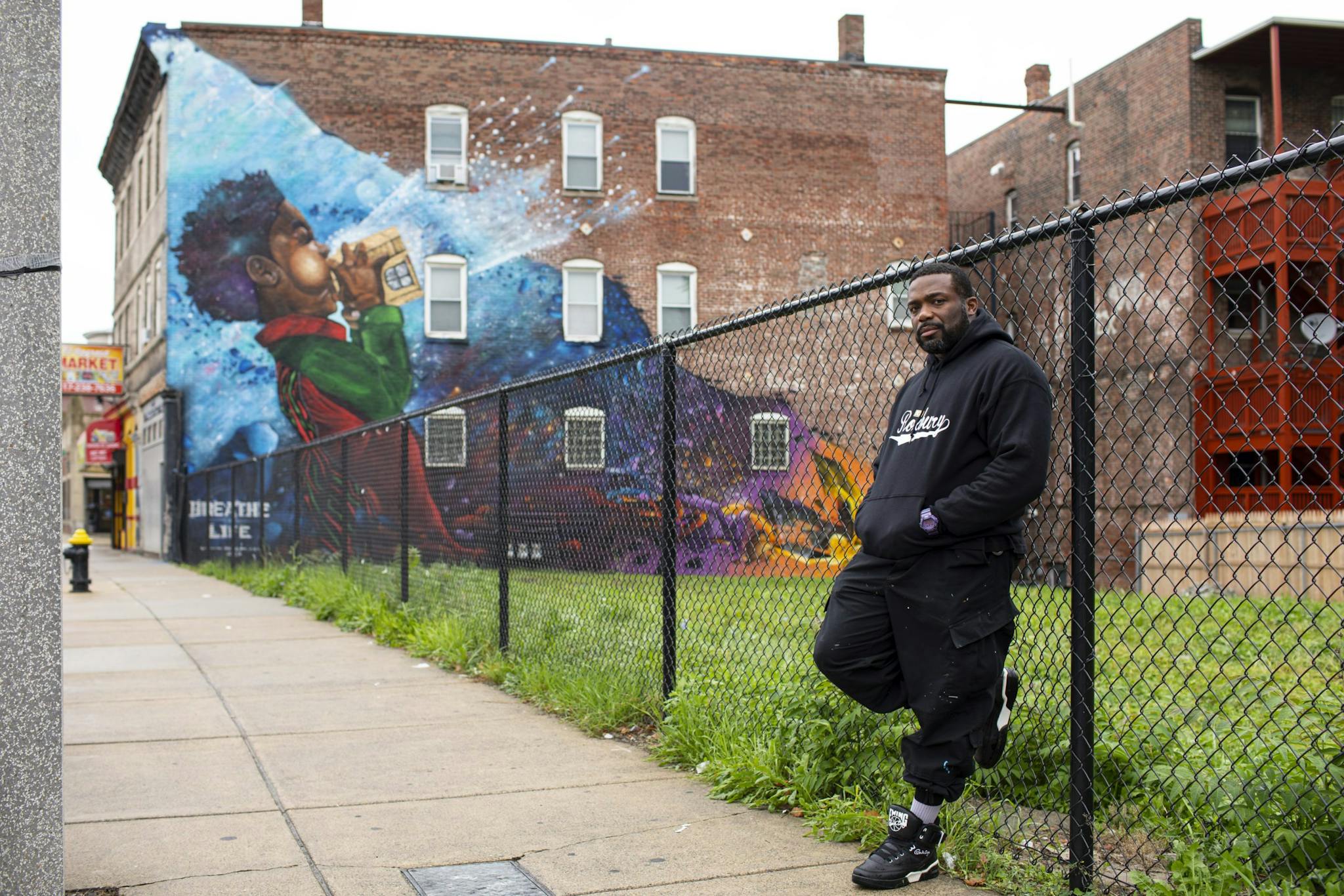This article was originally published in Issue 04: The Public Art Issue and is being published online on occasion of Rob “ProBlak” Gibbs’s recent commission for the Rose Kennedy Greenway. ProBlak’s Breath Life Together mural for Dewey Square marks the first time a Black Boston-Based artist has been commissioned for the annual mural project. It will be on view through May 2023.
Driving up a rugged side street in South Boston, I see a young man standing on a stool in a vacant parking lot. He waves his hands above his head and a streak of orange appears, tinting a window-sized canvas in front of him. Entranced, I pull over and get out, watching as he uses spray paint to emblazon a vivid skyline. Artist, educator, and Artists for Humanity co-founder Rob “Problak” Gibbs stands to the side, intently watching his student work.
“I’ve known him since he was thirteen,” ProBlak comments with a proud smile. “At the time, he was too young to work at Artists for Humanity.” Now, his student is fifteen and able to take a job at the nonprofit that invests in building youth’s creative skills.
I can’t give the student’s name because even in a city that loves “street art,” art that’s considered “graffiti” is still punishable by jail time and heavy fines. The student, who we’ll call B, weaves his way up buildings to dizzying heights that clear Boston’s skyline. B snaps a picture and uses the shot as a reference image for his art.
What he does is also technically illegal.
“I’ve met a lot of other artists doing this,” B tells me once he takes a break from his canvas. In his adventures scaling buildings, he’s run into others seeking that same thrill of adrenaline. And in this, he’s found a community of similarly motivated creatives.

Rob “ProBlak” Gibbs during the creation of Breath Life 3, 2019. Photo by G. Ortiz.
A gust of wind suddenly knocks over B’s large canvas, and the edge of the metal stand holding it up catches and tears the fabric. After some moments of readjustment and advice from Problak, B gets the canvas back up and resumes spraying. As he continues, I find myself aware of passersby watching B as he maneuvers the metal spray cans in his hands. Some are curious, others not so much, watching intently with narrowed eyes and pursed lips.
South Boston, where Artists for Humanity is located and where we’re watching B paint his skyline, is rapidly changing. It hugs the waterfront, segmented by a grid of alphabet-named streets. The vestiges of industrialism loom in its bowels. South Boston was always inhabited by predominantly minority communities, treading the line between poor and “low-income.” Now, a one-bedroom apartment in Southie could cost you up to $2,000 a month.
“I wanted to make sure to stay out here with him,” says ProBlak. As I catch the intensity of some of the stares, I fully understand why. A kid wielding spray paint cans in an empty parking lot? It’s a recipe for a graffiti-in-progress call.
Some would say that attitudes towards “graffiti” are changing as the city barges towards a “street art”-driven plan to restore and liven up spaces across the city. Realistically, it’s hard not to like street art—it’s bright and otherworldly, and if it’s good, it’ll make you pause and think. When street art is well-commissioned, the work is a reflection of the surrounding community while introducing something novel and new. There’s no shortage of beautiful street art. ProBlak would know— he’s created some of the most beautiful pieces around town.
However, that doesn’t mean he’s totally convinced about the aim of street art. “It’s a colorful sticker,” he says. “The art itself is beautiful. But sometimes ‘street art’ is used in the displacement process in our neighborhoods.”

Rob “ProBlak” Gibbs, Breathe Life 3, 2019. 808 Tremont St., Roxbury, 2019. Photo by G. Ortiz.
Street art has been the focus of articles (including this one), the subject of festivals, and a recipient of investment from the city of Boston. But graffiti, the very thing that birthed street art, is still woefully illegal. Conversations rise and fall about street art’s role in gentrification as more and more eye-catching murals crop up around Boston’s neighborhoods.
For some, “street art” signifies impending changes to the area. “When you see things like this, it makes you think, oh, they’re redoing the area or flipping it,” a Roxbury resident told me back in June as we watched ProBlak finish his mural Breathe Life 3. It’s a sentiment I often hear from members of the communities being displaced by gentrification. The mural, featuring a little black girl atop the shoulders of an older black boy, spans the side of a building on Tremont Street, bracing the divide between the predominantly black and brown neighborhood of Roxbury and the primarily white South End.
At the root of it all, the problem isn’t the art. It’s the process. It’s the systems of power involved that dictate who gets to paint what and where. Property managers and corporate entities actively seek out street art, visually redefining what “urban space” looks like. City-sanctioned street art is also carefully regulated by an application-based process. “City-sanctioned street art is a relatively new thing,” ProBlak tells me. “Even then, you have to know when the calls for proposals go out, and you have to know how to write a good proposal in the first place.”
Street art is widely accepted as something exciting and new, yet somehow, I can’t publish B’s full name for fear of possible legal repercussions. Something is very, very wrong with this picture. It brings to mind a question artists have been battling with since street art entered this resurgence period. Why is one art form venerated while the other is treated as a public nuisance? Why is one funded by the city and the other persecuted by the Boston Police Department? It all comes down to property, space, and ownership. Graffiti is defined by Massachusetts law as the defacement of private or public property by “painting, marking, scratching, or etching,” and is punishable by up to three years of jail time. Boston, in particular, has been cracking down on graffiti and “vandalism” since it sprung up in the city in the ’80s. Just a few months ago, South Boston police arrested South Boston resident Alexander Dunn for tagging street signs.

Rob “ProBlak” Gibbs at work. Photo by G. Ortiz for Boston Art Review.
Graffiti’s refusal to abide by social propriety and its unbridled, uncontrollable nature is why law enforcement is so keen to eradicate it. From the Berlin Wall to the subways of New York to the once elevated Orange Line in Boston, graffiti became a way to visually reclaim space. It was, quite literally, writing oneself into existence and that, in itself, was subversive. “It was the one thing that was undeniably ours and we had it since the subway was elevated all the way to Downtown,” ProBlak says. “That was the spine to the city from our neighborhoods. So whatever representation we had culture-wise, it was there.”
Walls acted as the galleries for burgeoning artists who never felt welcome or invited into traditional art spaces like galleries and museums. Graffiti was a way to practice, to establish a presence, and to write the community’s culture and history on the walls. In neighborhoods like Dorchester and Roxbury, murals also served this purpose. “The greats like Dana Chandler, Paul Goodnight…they called themselves urban landscapers,” ProBlak points out. Pieces like Gary Rickson’s Africa Is the Beginning, emblazoned on the side of a Roxbury YMCA, memorialized collective histories of the surrounding communities of color in ways that society at large neglected to.
Some would argue that murals or street art and graffiti are two very separate things. But the criminalization of graffiti restricts the artistic freedom graf writers have with their work. “594 is the violation code for graffiti,” ProBlak says. “We had to have lookouts and watch out, in shifts, to make sure the police weren’t rolling up on us mid-process.” Graf writers aren’t given the luxury of having hours and hours in daylight to work on a piece the way muralists do. Often in the cover of the night, they have to covertly create their artwork and return to it to complete it, if need be.
Because of graffiti’s criminalization, ProBlak and other graf juggernauts like Victor “Marka27” Quiñonez had to innovate different ways to expand their artwork. They’d approach business owners and ask if they wanted a mural or piece of work on their walls. Sometimes this approach worked and sometimes it didn’t. “The first wall we painted was Walnut Park Avenue,” ProBlak says. “We started o hunt for buildings in the city that had beautiful walls, and Vic [Marka27] would contact whoever was owning or leasing it.” He continues, “We used to really have to convince people to let us put these murals up. And when we did, we funded ourselves. We bought the supplies and the materials we needed.”

Rob “ProBlak” Gibbs at work. Photo by G. Ortiz for Boston Art Review.
Graffiti artists had to push to showcase their work on the walls of Boston, and it catalyzed the current conversation centering murals and street art. Ironically, these same artists can still be persecuted simply for having a can of spray paint in hand. In fact, spray paint and wide-tipped markers are what the police look out for when searching for graf artists. ProBlak’s watchful eye over B as he works is a reminder of that fact throughout our conversation. “It’s like once it’s a spray paint can, the attitude towards the art changes,” ProBlak comments. “It’s because of the medium. I could set up an easel and paint during the day for four months straight and nobody would bother me—it’s traditional. But if I had the same setup using spray paint, it’s a different story.”
There are a few havens, cornucopias of graffiti art, though these places are rapidly disappearing. In spaces like the underpasses of the Mass Pike and the now torn-down empty warehouses right outside of Dudley Square, graffiti art is given space to flourish, untethered by the constant concern that the police will show up. Inaccessible or unknown to outside of the graf community, these places showcase stunning, expansive pieces of work and incredibly intricate scenes that would be impossible to complete in an alleyway or on the side of an occupied building without getting arrested. However, pieces just like these are now being sanctioned for creation by the city or commissioned by property owners. The difference? One requires permission. The other represents an enduring lineage of the freedom of expression and choice.
When I ask ProBlak how it feels to be a black man with roots in both Dorchester and Roxbury participating in an art form that could play into gentrification, he takes a moment to answer. When he does, he answers honestly. “It’s hard, it really is.” Ultimately, he says, he creates “murals that act as mirrors” and reflect the people in his communities. But he’s also painfully aware that some of the buildings boasting “street art” don’t and may never house people from his community.
There is no clear or correct answer to a question like the one I asked. The weaponization of street art by city and corporate entities has wedged artists into an uncomfortable space of wanting to make art that speaks to the masses while knowing that sometimes these commissions for art have money-driven motives.
In a perfect world, street art wouldn’t be connected to displacement. In a perfect world, graffiti would be supported by the city, not criminalized. In a perfect world, the importance of “property” and “ownership” would not supersede artistic expression. But unfortunately, this isn’t a perfect world.
Until we get there, street art will exist in this questionable gray area. Until then, artists will occupy the tumultuous space between their art and what its presence indicates in surrounding communities. Until the city of Boston truly interrogates its criminalization of graffiti and its veneration of street art, there will be a perceived difference in prestige between the two. And, when it comes to street art, there will always be the question: who is this for?
This feature was originally published in Issue 04: The Public Art Issue




